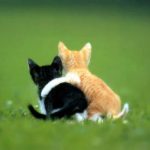For a cat lover’s there is no more wonderful sound than your cat’s purr. Rhythmic, calming and solid, a cat’s purr is one of life’s mysteries – or is it?
Why do cat’s purr?
Mostly we associate a cat’s purr with them being happy, warm and satisfied, which is by and large true. Although there are also cases of a cat purring with in a dangerous or anxious situation. Perhaps to calm themselves?
Psychologist Dr Stanley Coren suggests that purring is usually a sign of contentiment but that ???It may [also] be that purring is usually such a positive signal that cats gain reassurance from hearing their own purring sounds, much like a frightened child who whistles as he walks past a graveyard on a dark night. The cheery noises he is making give him encouragement that everything will turn out well.???
How do cat’s purr?
 Carolyn McDaniel, from Cornell University Feline Health Center, suggests that the, “cat???s purr originates in the larynx and is generated by oscillation of airway structures that result in turbulent airflow during respiration.”
Carolyn McDaniel, from Cornell University Feline Health Center, suggests that the, “cat???s purr originates in the larynx and is generated by oscillation of airway structures that result in turbulent airflow during respiration.”
Purring is innate, both domestic and wild felines purr pretty much from birth. Kittens purr before they can even open their eyes, which some suggest let’s the mother cat know her kitten is alive and well. The mother’s responsive purr also reassures the kitten that she is a ‘friend’ not foe.The vibrations from the mother???s purrs also allows her young kittens to find her when their sight has not yet developed.
What’s it good for?
 The Fauna Communications Research Institute in the US has recorded the purrs of different types of cat and found that they have a frequency between 25 and 150Hz. In physical therapy sound frequency of this range??can improve bone strength, mobility, strengthen muscles, ligaments and tendons, and to lessen pain and swelling.??Since the purr has lasted through hundreds of cat generations, it follows that there must be a survival mechanism behind it, and many scientists believe it is a natural healing tool.
The Fauna Communications Research Institute in the US has recorded the purrs of different types of cat and found that they have a frequency between 25 and 150Hz. In physical therapy sound frequency of this range??can improve bone strength, mobility, strengthen muscles, ligaments and tendons, and to lessen pain and swelling.??Since the purr has lasted through hundreds of cat generations, it follows that there must be a survival mechanism behind it, and many scientists believe it is a natural healing tool.
Purring requires energy and since cat’s are fairly partial to not exercising all that much,??purring while resting expends energy, bone growth, increases muscle, ligament strength, and maintains good health.
The study found that our feline friends will modify their signature purr when seeking food, adding a higher-frequency element (300 to 600Hz) that is remarkably similar to that of a baby???s cry. The resulting mixed signal taps into a natural human nurturing instinct and is extremely difficult to ignore, according to animal behaviourist Dr Karen McComb of Sussex University.
Dr McComb was originally inspired to do the research by experiences with her own cat, which often wakes her in the morning with an insistent purr. ???The embedding of a cry within a call that we normally associate with contentment is quite a subtle means of eliciting a response,??? she says. ???Solicitation purring is probably more acceptable than overt meowing, which is likely to get a cat ejected from the bedroom!???
 This Blog was written by the furry family at??Petplan Pet Insurance??&??Petplan Equine??Australia. We love pets and ??people who love pets!??We offer pet Insurance for Dogs, Cats, Horses & Ponies (including third party liability; horse floats, saddlery & tack). We specialise in ???covered for life??? dog insurance, cat insurance and equine insurance. Please visit us on??facebook??or on our??website.
This Blog was written by the furry family at??Petplan Pet Insurance??&??Petplan Equine??Australia. We love pets and ??people who love pets!??We offer pet Insurance for Dogs, Cats, Horses & Ponies (including third party liability; horse floats, saddlery & tack). We specialise in ???covered for life??? dog insurance, cat insurance and equine insurance. Please visit us on??facebook??or on our??website.


